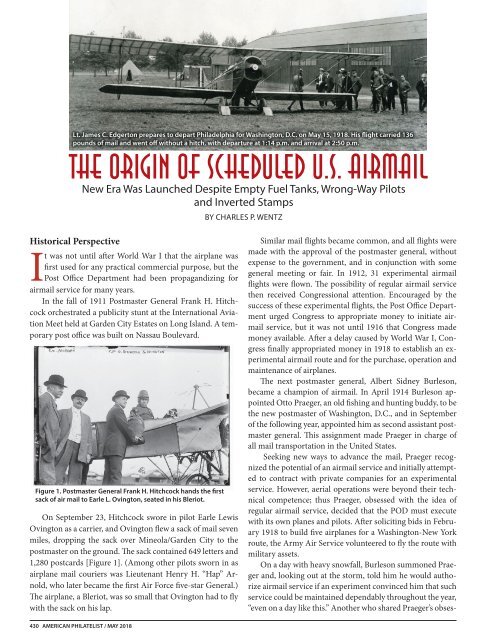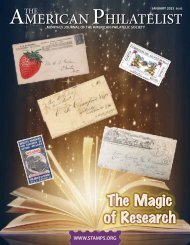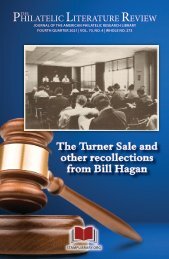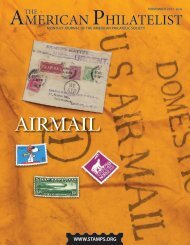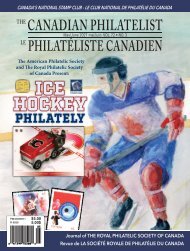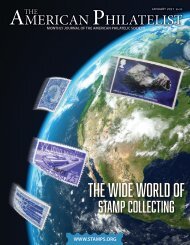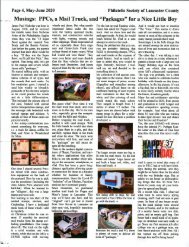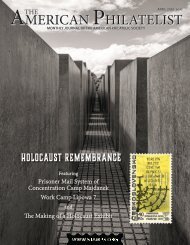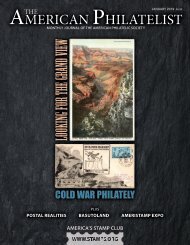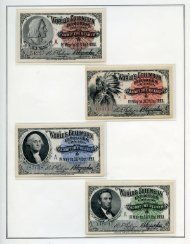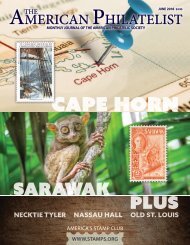The American Philatelist May 2018
- No tags were found...
Create successful ePaper yourself
Turn your PDF publications into a flip-book with our unique Google optimized e-Paper software.
Lt. James C. Edgerton prepares to depart Philadelphia for Washington, D.C. on <strong>May</strong> 15, 1918. His flight carried 136<br />
pounds of mail and went off without a hitch, with departure at 1:14 p.m. and arrival at 2:50 p.m.<br />
<strong>The</strong> Origin of Scheduled U.S. Airmail<br />
New Era Was Launched Despite Empty Fuel Tanks, Wrong-Way Pilots<br />
and Inverted Stamps<br />
BY CHARLES P. WENTZ<br />
Historical Perspective<br />
It was not until after World War I that the airplane was<br />
first used for any practical commercial purpose, but the<br />
Post Office Department had been propagandizing for<br />
airmail service for many years.<br />
In the fall of 1911 Postmaster General Frank H. Hitchcock<br />
orchestrated a publicity stunt at the International Aviation<br />
Meet held at Garden City Estates on Long Island. A temporary<br />
post office was built on Nassau Boulevard.<br />
Figure 1. Postmaster General Frank H. Hitchcock hands the first<br />
sack of air mail to Earle L. Ovington, seated in his Bleriot.<br />
On September 23, Hitchcock swore in pilot Earle Lewis<br />
Ovington as a carrier, and Ovington flew a sack of mail seven<br />
miles, dropping the sack over Mineola/Garden City to the<br />
postmaster on the ground. <strong>The</strong> sack contained 649 letters and<br />
1,280 postcards [Figure 1]. (Among other pilots sworn in as<br />
airplane mail couriers was Lieutenant Henry H. “Hap” Arnold,<br />
who later became the first Air Force five-star General.)<br />
<strong>The</strong> airplane, a Bleriot, was so small that Ovington had to fly<br />
with the sack on his lap.<br />
Similar mail flights became common, and all flights were<br />
made with the approval of the postmaster general, without<br />
expense to the government, and in conjunction with some<br />
general meeting or fair. In 1912, 31 experimental airmail<br />
flights were flown. <strong>The</strong> possibility of regular airmail service<br />
then received Congressional attention. Encouraged by the<br />
success of these experimental flights, the Post Office Department<br />
urged Congress to appropriate money to initiate airmail<br />
service, but it was not until 1916 that Congress made<br />
money available. After a delay caused by World War I, Congress<br />
finally appropriated money in 1918 to establish an experimental<br />
airmail route and for the purchase, operation and<br />
maintenance of airplanes.<br />
<strong>The</strong> next postmaster general, Albert Sidney Burleson,<br />
became a champion of airmail. In April 1914 Burleson appointed<br />
Otto Praeger, an old fishing and hunting buddy, to be<br />
the new postmaster of Washington, D.C., and in September<br />
of the following year, appointed him as second assistant postmaster<br />
general. This assignment made Praeger in charge of<br />
all mail transportation in the United States.<br />
Seeking new ways to advance the mail, Praeger recognized<br />
the potential of an airmail service and initially attempted<br />
to contract with private companies for an experimental<br />
service. However, aerial operations were beyond their technical<br />
competence; thus Praeger, obsessed with the idea of<br />
regular airmail service, decided that the POD must execute<br />
with its own planes and pilots. After soliciting bids in February<br />
1918 to build five airplanes for a Washington-New York<br />
route, the Army Air Service volunteered to fly the route with<br />
military assets.<br />
On a day with heavy snowfall, Burleson summoned Praeger<br />
and, looking out at the storm, told him he would authorize<br />
airmail service if an experiment convinced him that such<br />
service could be maintained dependably throughout the year,<br />
“even on a day like this.” Another who shared Praeger’s obses-<br />
430 AMERICAN PHILATELIST / MAY <strong>2018</strong>


